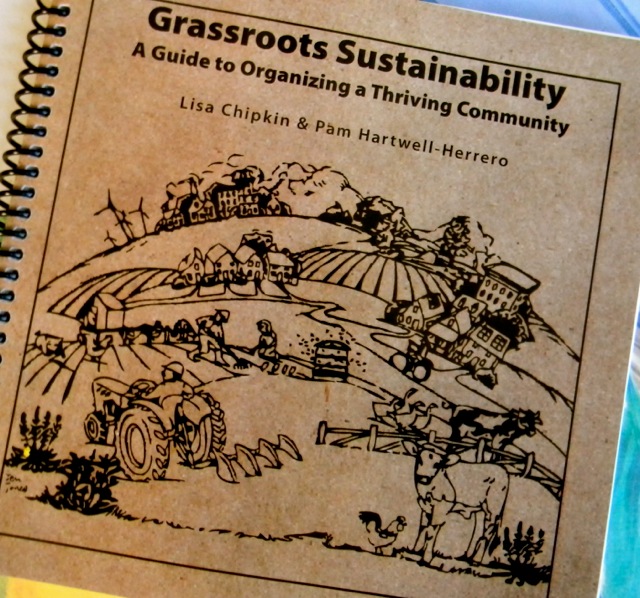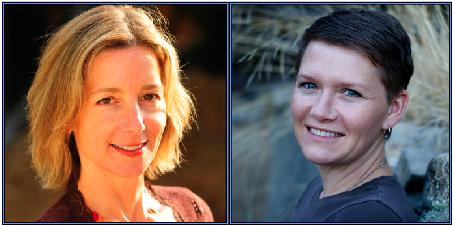
Wondering how to create a city-wide plastic bag ban or a green building ordinance, or how to stop a government planned aerial pesticide spraying of your own 'hood? Two dynamic sustainability experts and community organizers were recently involved in all of the above changes in their own communities. And now they've written a book with the secret codes!
Grassroots Sustainability: A Guide to Organizing a Thriving Community by artist and writer Lisa Chipkin and Fairfax, Calif. Mayor Pam Hartwell-Herrero will inspire you to take action, get some peeps (your leadership team), set long term goals, educate your community, and ultimately survive the rough spots on the road to revising public policies. I spoke with the authors about their inspirational new book that asks us all to break through our fears, roll up our sleeves and get to work changing the world for good.

Photo: Annie Spiegelman
You two seem to think that continuing to pollute our natural resources is so yesterday! Today is about sustainability. What is your own personal definition of sustainability?
Lisa Chipkin: We believe a thriving community, one in which there is a strong sense of place, connectedness and belonging, as well as a strong local economy and a healthy diverse environment, is a sustainable one.
Pam Hartwell-Herrero: The more I live with sustainability and birthing it into the community and growing it in the community the more I feel it's about changing our culture to appreciate the abundance that comes with learning how to live differently together. It's a good culture that feels really rich and whole.
LC: I also see sustainability as living in full appreciation and respect for all members of the community (local and global), the rich and diverse offerings and resources available within the community, the conscientious stewardship and protection of the planet- its natural systems and resources, flora and fauna, and the responsible, intelligent and innovative production, distribution, consumption, and regeneration of all goods and services.
You state that making policy change is about collaboration and building lasting positive relationships in your community? How do you do that?
PHH: This has been a critical part of the work that we do. It makes the work stronger and makes us all feel more supported. We think the best way to build a positive relationship is through collaboration, and always looking out to be sure you're benefiting each other. We never ask for anything unless we have something positive to return. This makes both sides feel really good about whatever it is we're working on.
It is critical for advocacy groups to approach all potential collaborators in a really respectful way, with the belief that workable, win-win solutions are possible. This approach inspires people to want to work with you, garners the support you need for your issue or cause, and helps build the coalitions that allow you to become more effective in your work.

Authors, (L) Lisa Chipkin and (R) Mayor Pam Hartwell-Herrero. Photo Credit:Lulu.com
You write, "Try to end meetings on a positive note." That can be a challenge when discussing climate change, water pollution, overcrowded landfills, escalating asthma rates and pesticide-ridden food?
LC: They are big and scary, especially when you look at them all at once on a global scale. But when you begin in your own community, they become more manageable, though still challenging... Cultivating not taking it all personally should be part of the practice, otherwise, we'll just suffer endlessly and lose faith in the work and the process of bringing about positive change.
It also comes back to relationships -- in order to get a group of people to dedicate their time and energy to these really difficult problems, you have to have a really positive attitude, one of "we're here to solve it." Having this mindset is incredibly important as you engage with like-minded others to build sustainability into the fabric of your local community, where you have more control. You also have to trust that your local efforts are part of a greater whole that you can't necessarily see in every moment, and that all efforts made, no matter how small or large, make a difference and are needed to create the thriving sustainable world in which we want to live.
Explain your collaboration with county supervisors and city council members. How much caffeiene does it take to stay awake during the meetings... ?
PHH: Elected officials serve under the great challenge of meeting the needs of their whole community, so sometimes it can be especially helpful for them to have the support of advocacy groups.
Locally, we are fortunate to have had some really effective leaders amongst our elected officials, people like Hal Brown and Charles McGlashan who have taken on and championed projects like Marin Clean Energy and the Plastic Bag Ban brought to them by advocacy groups. Sometimes they provide support from their staff, or a city council member will direct staff to take time to work with advocates to develop a really progressive green building ordinance for their community, etc.
Many of these kinds of projects and ordinances have become models for other communities around the country. Elected officials can also dedicate funds or direct grant money to advocacy groups to complete projects more effectively than they can due to bureaucracy and limited staff time. At the town level they can author and support a variety of local ordinances and resolutions that make big leaps for sustainability.
Fairfax, California's city council recently passed the most progressive contract with a garbage "resource" hauler that will help get the community to 94 percent diversion away from the landfill for items at the curbside. This contract will act as a model for other communities.
You write, "Just begin." Author Jean Shinoda Bolen claims Mother Earth is sending us an urgent message to "gather the women and save the world." What message can you say to other women reading this interview who may be afraid to step up and speak out against environmental degradation?
PHH and LC: We don't believe our book is directed just to women; it's for everyone. Women seem to often hold a lot of the weight of this kind of work and do it incredibly well, but of course there are also wonderful men involved. Really we need men, women, children -- people of all ages to step up and participate in whatever ways they can so that change can happen.
At the same time, perhaps because we give birth, women tend to have that drive to nurture and will often be inclined to mother in their community in some way. And women can feel really isolated and terrified about the world we are bringing our children into. But getting together with other women and men to change the world is a healing salve for that despair as well as a powerful way to model to our children that change is possible.
It can also be easy to get out of balance and burn out doing this kind of work as we become overly passionate about the causes to which we are committed. So, working to retain balance and joy is crucial -- without that we are not as effective.
Ultimately, working in this way with like-minded others, being committed to positive change, and bringing heart, humor (if you aren't able to laugh, it can feel all the more intense and scary), intelligence and persistence to the work should feel good and be fun. And you're likely to make some great new friends and gain a support system in the process.
Visit www.grassrootssustainability.org for more information.
Visit Annie at www.dirtdiva.com.
